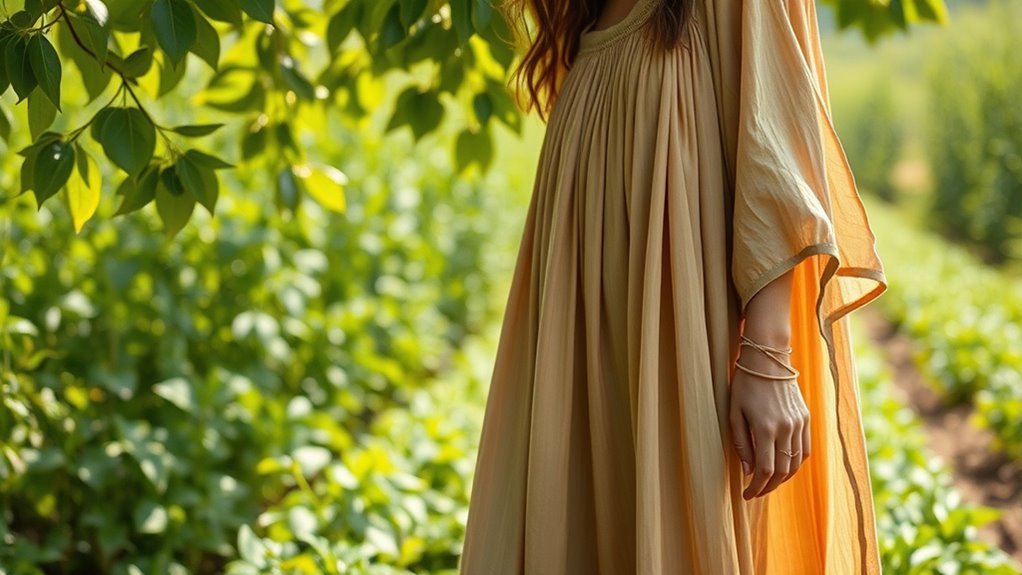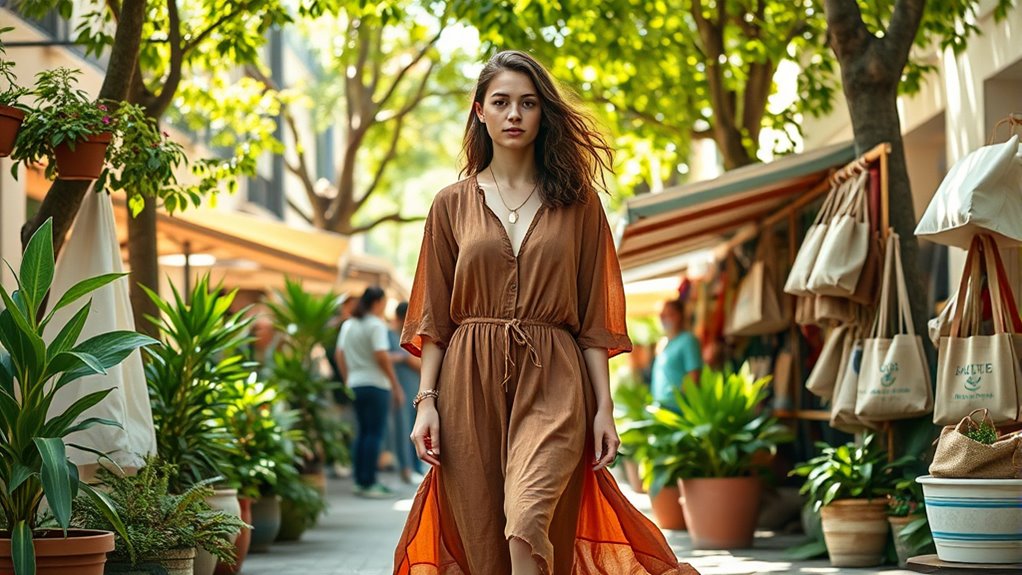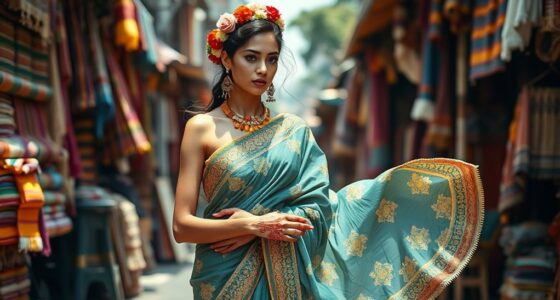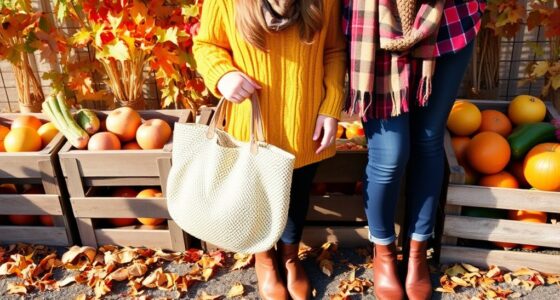To start your eco-friendly fashion journey, focus on brands that prioritize textile recycling and fair trade practices. Choose secondhand pieces or invest in high-quality items that last longer, reducing waste. Look for certifications that confirm sustainability efforts and support your values. Educate yourself about the lifecycle of clothing and opt for sustainable materials whenever possible. Moving toward conscious consumption helps minimize environmental impact and promotes ethical practices—keep exploring to learn how you can make better style choices.
Key Takeaways
- Choose brands that prioritize textile recycling, fair trade, and transparent sustainability practices.
- Support secondhand shopping and invest in durable, high-quality pieces to reduce waste.
- Look for eco-labels and certifications indicating environmentally responsible production.
- Educate yourself on the lifecycle of clothing and the impact of different materials.
- Incorporate sustainable habits like donating, upcycling, and using eco-friendly technology.

Have you ever wondered how your fashion choices impact the environment? Every item you buy and wear has a footprint, from how it’s made to how it’s disposed of. But the good news is, you can make smarter, more eco-friendly decisions that benefit both the planet and the people involved in production. One of the most effective ways to start is by exploring textile recycling. Instead of tossing out old clothes, you can donate, upcycle, or shop from brands that prioritize textile recycling, which reduces waste and minimizes the need for new raw materials. Recycling textiles prevents fabrics from ending up in landfills, where they take years to decompose and can release harmful substances into the environment. By choosing to support brands that incorporate textile recycling into their processes, you’re actively contributing to a circular fashion economy that values reuse and waste reduction.
Supporting textile recycling helps reduce waste and promotes a circular fashion economy that benefits the planet.
Another vital aspect of sustainable fashion is fair trade sourcing. When you look for brands that prioritize fair trade practices, you’re ensuring that workers involved in making your clothes earn fair wages and work in safe conditions. Fair trade sourcing also encourages environmentally responsible practices, such as using sustainable water management and reducing chemical use. When you buy from these brands, you’re supporting a system that values transparency and social responsibility, helping to uplift communities and protect ecosystems. It’s a simple yet impactful way to make your wardrobe more ethical and environmentally friendly.
Getting started with eco-friendly fashion doesn’t mean you have to overhaul your entire wardrobe overnight. You can begin by researching brands that prioritize textile recycling and fair trade sourcing. Look for certifications or labels that verify these practices, and read the stories behind the brands to understand their commitment to sustainability. Shopping secondhand is another excellent way to reduce demand for new textiles and give clothes a second life. Additionally, investing in high-quality pieces that last longer means fewer replacements and less waste over time.
Finally, educate yourself about the lifecycle of your clothes and the companies you support. The more informed you are, the better decisions you’ll make. Remember, small changes in your shopping habits—like choosing sustainable materials, supporting ethical brands, and recycling textiles—add up. Your choices have the power to influence the fashion industry toward a greener, more equitable future. With every conscious purchase, you’re taking a step closer to a style that’s not only fashionable but also kind to the planet. Incorporating high-quality projectors into your home cinema setup can further enhance your viewing experience while supporting sustainable choices through energy-efficient and eco-friendly technology.
Frequently Asked Questions
How Can I Tell if a Brand Is Genuinely Eco-Friendly?
You can tell if a brand is genuinely eco-friendly by checking for certification labels like Fair Trade or GOTS, which verify their sustainability claims. Also, look for brands with transparent supply chains—they openly share information about their sourcing and manufacturing processes. When a brand provides clear, verifiable details and holds recognized certifications, you’re more confident that they truly prioritize eco-friendly practices rather than just greenwashing.
What Are the Most Sustainable Fabrics to Look For?
Think of sustainable fabrics as the roots of a thriving tree—you want strong, healthy options. Look for organic fibers like organic cotton and hemp, which grow without harmful chemicals. Renewable textiles, such as Tencel and linen, come from fast-growing plants, making them eco-friendly choices. These fabrics help reduce environmental impact, so you can wear your values proudly and support a more sustainable fashion future.
How Do Eco-Friendly Fashion Prices Compare to Fast Fashion?
You’ll find that eco-friendly fashion often has a higher initial cost compared to fast fashion, but the cost comparison changes over time. While fast fashion offers lower prices, eco-friendly pieces tend to be more durable, reducing the need for frequent replacements. Quality differences mean you get better craftsmanship and longer-lasting garments, making eco-friendly options a smarter investment in the long run. Plus, you support sustainable practices with each purchase.
Can Secondhand Shopping Be Truly Sustainable?
Secondhand shopping can be truly sustainable if you focus on upcycling techniques and embrace vintage authenticity. When you choose to buy pre-loved items, you extend their life and reduce waste. By upcycling, you transform pieces into something new and unique, making your wardrobe more eco-friendly. Vintage finds often have a story, adding authenticity and character. So, your secondhand choices support sustainability while giving you one-of-a-kind fashion.
What Are Easy Ways to Start an Eco-Friendly Wardrobe?
To start an eco-friendly wardrobe, try thrift shopping for quality pieces that last, reducing waste. Focus on building a capsule wardrobe with versatile, timeless items—this minimizes overconsumption. Opt for natural fabrics like organic cotton or hemp, and wash clothes in eco-friendly ways. These simple steps help you reduce your environmental impact while creating a stylish, sustainable closet you love.
Conclusion
By choosing eco-friendly fashion options, you’re making a positive impact on the planet and your wardrobe. Every small step, from selecting sustainable fabrics to supporting ethical brands, adds up to a more mindful style. Isn’t it rewarding to know your fashion choices can help protect the environment? So next time you shop, ask yourself: are you ready to embrace a more sustainable, stylish future? Your wardrobe—and the Earth—will thank you.









